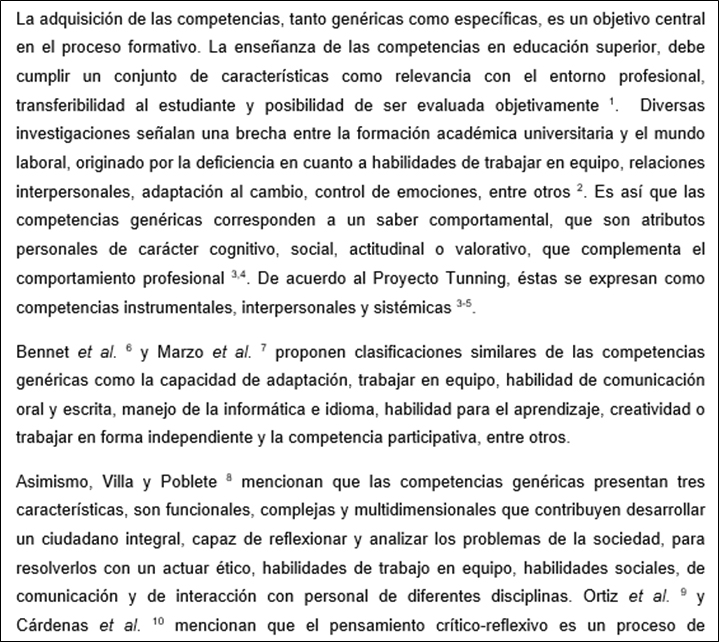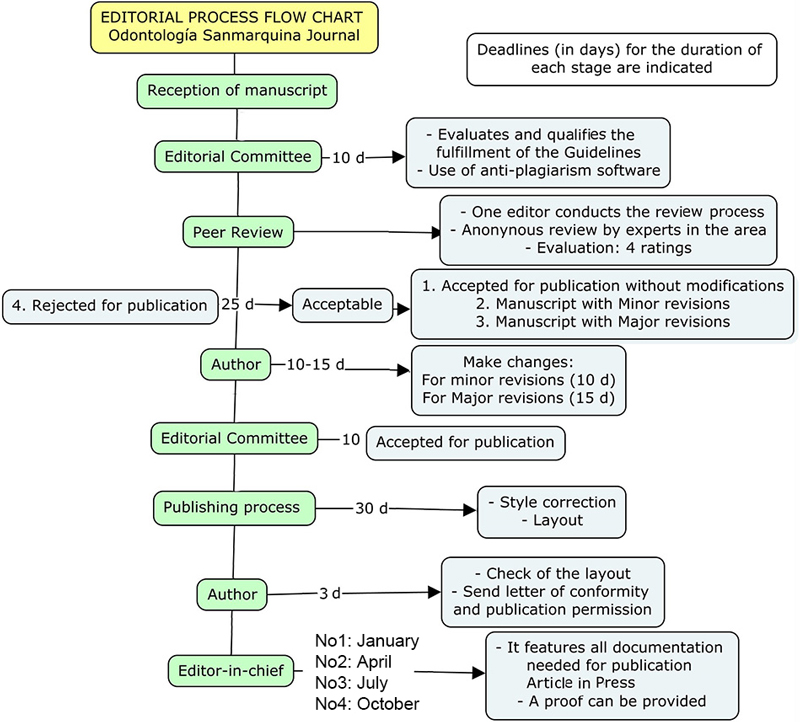Submissions
Submission Preparation Checklist
All submissions must meet the following requirements.
- The work is written in a Microsoft Word file, without passwords or impediments for a transparent reading and review.
- The article text , the citations, the titles of figures and tables, as well as their legends and notes, have been written according to Odontologia Sanmarquina standards, and Vancouver reference styles.
- The submitted work has been read and approved by all the authors, who agree on the representation of the corresponding author.
- The bibliographic references are in Vancouver style and present DOI or a persistent identifier (eg: in the case of thesis URI or Handle).
- All authors have read and agree to the editorial policies mentioned in these guidelines for submitting papers to Odontología Sanmarquina.
- The work has not been previously published, nor has it been submitted to another journal (or an explanation has been provided in Comments to the editor).
- The ORCID codes of each of the authors are indicated, the name of the author to whom information may be sent (corresponding author) is provided, declarations of: Authors' affidavit, Conflict of interest and Funding sources are sent.
Articles
Research papers that have not been published in other research journals, which are written in such a way that even the author´s peers can, based on the indications of the text, reproduce the experiments and obtain similar results and verify the accuracy of the analyzes used to reach the conclusions of the document. The maximum length for these articles is 15 pages and 10 tables and/or figures. The main text of the original articles must be organized as follows: Abstract in Spanish and English, Introduction, Methods, Results, Discussion and Bibliographic references.
Clinical Cases
Consist on the description of one or more clinical cases of special interest, and also new surgical techniques or variants of them, analysis of results obtained with a particular technique or treatment of a rare or complex pathology. The maximum number of signing authors will be five. The abstract and its translation should have no more than 200 words with two to five keywords. The abstract will be unstructured and should contain: objective, description of the case, clinical outcome and conclusions. A maximum of 15 tables and/or figures are permitted. Graphics should facilitate the understanding of the case report. The main body of clinical reports should be organized as follows: Introduction, Case report (must include the diagnosis, treatment, follow-up and results) Discussion and Bibliographic references.
Review
Present the results of a finished research and analyzes, systematizes and integrates research results published or unpublished, in science and/or technology, in order to report the progress and development trends. It is characterized by presenting a carefully elaborated bibliographic review of a specific topic. It must have a maximum of 15 pages, and it may be submitted up to five tables and/or figures to facilitate the understanding of the text. An unstructured abstract with no more than 250 words that features introduction, relevant aspects and conclusions should be presented. The minimum number of references is 30. The main content of the review articles should be organized as follows: Introduction, Review of current literature, Conclusions and Bibliographic references. The structure of the systematic reviews should follow that of the original articles and up to 10 tables and / or figures.
Historical review
Document summarizing the historical information related to national and/or international dentistry, including biographical notes of characters who have made an outstanding contribution to this field. Also, documents related to the evolution and development of technologies and innovations related to dental research subjects can be found in this section. The text should be organized as follows: Introduction, Body of Review, Conclusions and Bibliographic references. The maximum number of authors allowed is three.
Scientific Note
These articles include the discussion or display of topics of interest to the scientific community. The body of the note can be organized as: Introduction, Body of the note, Conclusions and Bibliographic references. The maximum number of authors allowed is three.
Interviews
These articles are submitted at the request of the Editor-in-Chief of the journal, include interviews with experts on a particular subject. The interview can be organized as: Introduction, Body of the interview and Bibliographic references.
Letters to the Editor
Objections or comments concerning published works in the last two issues of the journal, topics or matters of professional interest, as well as observations, research and/or experiences written briefly will be published. The maximum number of authors allowed is three. Those letters that relate to previously published articles in the journal will have the right to be replied by the author who can answer in a letter of similar extension within one month. The relevance of the publication of the reply will be evaluated by the Editorial Board. It may be included two tables and/or figures and up to ten references. The main text of a letter to the editor comprises: Comment Body and Bibliographic references.
Copyright Notice
AUTHORS RETAIN THEIR RIGHTS:
a. Authors retain their trade mark rights and patent, and also on any process or procedure described in the article.
b. Authors retain their right to share, copy, distribute, perform and publicly communicate their article (eg, to place their article in an institutional repository or publish it in a book), with an acknowledgment of its initial publication in the Odontología Sanmarquina.
c. Authors retain theirs right to make a subsequent publication of their work, to use the article or any part thereof (eg a compilation of his papers, lecture notes, thesis, or a book), always indicating the source of publication (the originator of the work, journal, volume, number and date).
Privacy Statement
The names and email addresses entered in this journal will be used exclusively for the stated purposes of this journal and will not be available for any other purpose or another person.







